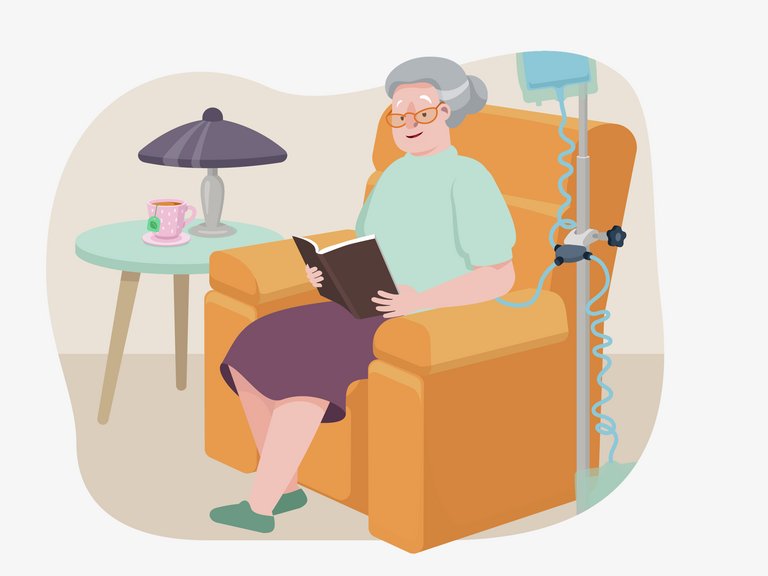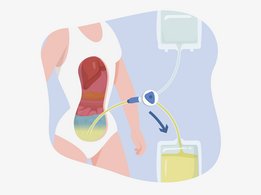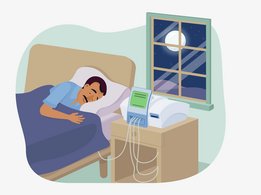The catheter stays in place the entire time a patient is on peritoneal dialysis therapy. When dialysate is present in the peritoneal cavity, removal of waste products and excess water takes place until the concentrations of solutes on the blood side and the dialysate side are equilibrated. This movement of water and waste products takes place during the dwell time. After a certain dwell time, the infused dialysate is drained out again via the catheter. Peritoneal dialysis continues as the drained PD fluid is replaced with fresh PD fluid. This process of replacing the used PD fluid with fresh PD fluid is called an exchange. An exchange is repeated several times a day, usually 4-5 times.
Peritoneal dialysis at Home

In peritoneal dialysis a part of the peritoneum is used as a dialyser. Water and solutes are able to move from the blood side to the dialysate side through the peritoneal membrane, which is a very thin layer of skin that covers the intestines and the liver. About two litres of dialysis fluid are slowly infused into the abdominal cavity via a flexible silicone tube, called a catheter.
Peritoneal access

If you choose PD, you will need to have a catheter implanted into your abdomen. The catheter carries the PD fluid into and out of your abdomen. It is an approximately 30 cm long soft silicone tube and as wide as a pencil. Part of the catheter lies inside the abdomen while the other part lies outside the body.
You do not have to worry that the implanted catheter may fall out. You cannot see because it is under your skin, but the catheter has cuffs which hold it in place. Body tissue will grow around the cuffs after a certain period. This gives the catheter the required stability. Nevertheless, it is important that the catheter is secured on the skin to prevent pulling. You can gradually start to fill the abdomen with PD fluid approximately two weeks after catheter insertion.
Hygiene in peritoneal dialysis
The skin is a natural barrier to microorganisms. If the skin has little ruptures, harmful organisms can enter our body and bloodstream and may cause an infection. This is why a good fixation of your catheter is extremely important. Otherwise, the movement of the catheter will cause damage to the skin at the exit site, and this might result in an infection.
In PD it is vital to follow strict hygiene techniques in order to prevent microorganisms from entering the peritoneal cavity via the catheter, catheter extension or during the bag connection. Applying hygiene rules in your daily routine is the best way to keep you from getting an infection of the peritoneum, called peritonitis.

Peritoneal dialysis can be carried out in two ways:
- Manually: CAPD – Continuous Ambulatory Peritoneal Dialysis
- Automatically: APD – Automated Peritoneal Dialysis
The choice between the two options depends on medical conditions, lifestyle aspects and personal likes and dislikes. Discuss what is the best treatment modality for you with your doctor and PD nurse.
CAPD (Continuous Ambulatory Peritoneal Dialysis) – manual exchange
In CAPD, most exchanges take place during the day. Typically, four to five exchanges a day are performed. Your doctor will prescribe how many exchanges per day are necessary to provide adequate dialysis treatment. Each exchange takes about 20-30 minutes. Exchange times can vary somewhat to fit your schedule, especially if you work or go to school. Your healthcare team will help you to set up a schedule that works best for you.
APD (Automated Peritoneal Dialysis) – automatic exchange
In APD, most exchanges take place during the night with the help of a device called a cycler. You are connected to the cycler for approximately 8 - 10 hours. The PD fluid is delivered via a special tubing set from the cycler to the patient. The cycler drains and refills the peritoneal cavity automatically while you sleep. In the morning you disconnect yourself from the cycler and you are free for your daily activities. There are different prescriptions on APD, depending on your lifestyle and medical condition.
Support & service

You will be asked to come for a visit to your dialysis centre every 4-12 weeks. During the visit, a blood sample will be taken to determine whether any changes have developed since the last visit and if your treatment needs to be adjusted. Together with you, your doctor will review these laboratory results, your medication sheet and your diet. Your records from home will also be reviewed to check your vital signs such as blood pressure, pulse, temperature and weight. Your peritoneal catheter and exit site will be examined.
Peritoneal dialysis supplies
Your dialysis prescription is specific to your needs. Your doctor and your nurse complete and sign a prescription list with your supplies and the amounts necessary for your treatment. Please remember: Changes to your prescription must always be made by your doctor!
Safety stock is used if a delivery is delayed due to no one being at home, bad weather, or in case your prescription changes. All supplies will be taken to your storage area. Your customer service representative will then contact you two weeks after your first shipment to determine your inventory and assist you in ordering supplies for your next delivery.
